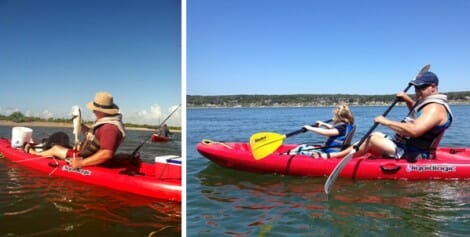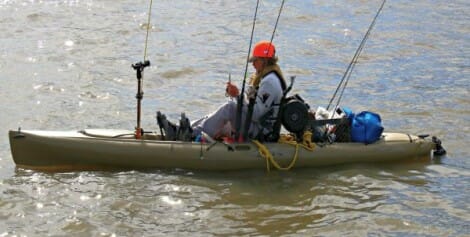 By Bob Currie, Vessel Examiner
By Bob Currie, Vessel Examiner
United States Coast Guard Auxiliary Flotilla 081-06-08
USCG Auxiliary Flotilla 081-06-08 is based at Coast Guard Station Galveston. The Auxiliary’s vessel examiners perform safety checks on all types of recreational boats. We have had a long discussion on the U.S. Coast Guard Vessel Safety Check. Let’s take a new tack and discuss a type of marine mammal we see on the water. They are everywhere that fish can be found. You see them in the surf. You see them when you cross on the ferry. You see them in Galveston East Bay. You see them chasing fish into the marshes. You even see them when you are fishing the near oil rigs. No- not dolphins. I am talking about paddlecraft operators. So please hang with me in this discussion, because if they are everywhere (and they are), you need to know about them and how to operate around them, and give them the respect they deserve.
Who Are They
The simple answer is they are us. A great number of people who own powerboats and sailboats of all sorts also own and use kayaks and other paddlecraft. These self-propelled boats and their operators are just as important to the U.S. Coast Guard as the owner of any other type of boat, and the Coast Guard has developed a Vessel Safety Check (VSC) specifically for paddlecraft and encourages vessel examiners like myself to reach out to as many paddlecraft operators as we do powerboat and sailboat operators. Some vessel examiners specialize in VSC’s for paddlecraft. Yes, you get a VSC sticker for passing a paddlecraft inspection. That sticker represents that the boater is pledging to maintain his or her craft and equipment to the standard of safety exhibited during the examination. I own two kayaks, and can be found fishing the bay and marshes, and occasionally the surf on my kayak. In one picture I am holding a rat red I caught just across the Intracoastal Waterway from Stingaree’s Restaurant. In the other I am paddling with one of my granddaughters.

What Are They
Most of the paddlecraft found in our waters are kayaks, and that is on what we will concentrate. The two basic designs of kayaks are sit-on-top and sit-inside. The sit-on-top models suit themselves well to the surf and in water where waves break across the top of the kayak. The sit-on-top models cannot be swamped. They can be capsized, though, and that is why you should not operate too close to them in your powerboat unless you are not creating a wake. Kayaks are used for the same thing as powerboats: cruising, fishing, and simply enjoying the water. Operating a kayak requires special knowledge, however, and one purpose of the paddlecraft VSC is to impart some of that knowledge to the boater. The Marine Awareness recommendations portion of the regular VSC concerns being aware of paddlecraft and how to maneuver around them. The following discussions center around safety on the water for paddlecraft, but the intended audience is all boaters. Although some of the rules for powerboats and sailboats apply to paddlecraft, there is enough difference that the Coast Guard created a separate examination and education program for paddlecraft, and, for that matter, Personal Water Craft (PWC), also known as jet skis.
Why Are They Out There
Paddlecraft have been around since the dawn of time. The first kayak may have been made of whale bones and seal skin, but the latest models are just as sophisticated as that 21-foot center console bay fisher or open-bow runabout. You have GPS and sonar on your powerboat? Many kayakers have the same models of GPS/sonar combos as you do. You carry an array of fishing tackle to handle any type of fish you encounter? All of that stuff can be carried on a kayak. You have a live well for your bait on your powerboat? Many kayaks do too. You like to stand up when you fish? Many kayaks have a standing platform and are stable enough to fish standing up. About the only thing that a kayak can’t match is the range of a powerboat, although paddlecraft operators often paddle 10-20 miles a day in their pursuit of happiness on the water. Paddlecraft never run out of fuel, though the operator might run out of energy. As Dirty Harry always said, you have to know your limits.

What’s In This for Powerboaters and Sailboaters
Although the next several columns are centered on safe paddlecraft operation, the intended audience is all boaters. We all share the water (and the boat ramps, for that matter; yes, paddlecraft pay launch fees too), and we all can benefit from knowing about the safe operation of all types of boats. Many of my powerboat and sailboat friends also own and operate paddlecraft. The reasons and benefits are many: improvement in health from the exercise, reaching fish that can’t be reached by powerboats, and the fellowship that can be found among paddlecraft operators is the best. Don’t forget about economy of operation. Instead of spending $400 for fuel, ice, and bait, you can be on the water for free with a kayak (or maybe just for a launch fee). Many paddlecraft fishermen use artificial bait (which can be used over and over), but live bait can be used with an aerated bucket or, if you have one of the fancy rigs, a live well in the hull of your kayak. Yes, I am a fisherman, but sometimes I launch my kayak just for the exercise or to see the natural beauty of the marshes. Paddlecraft open up a whole new world on the water. You can hear things that you can never hear running a powerboat. Sailors will attest to that.
Kayaking is not just a cheap method of getting on the water, although you can purchase an entry level kayak for just a couple of hundred dollars. Specialized kayaks can cost thousands of dollars, though, and there has been an increase in high end fishing and whitewater kayaking models that can cost as much as a powerboat. So, it’s not just about the cost. It is more about the experience than anything else.
So, the point I am trying to make is that the following discussions of the Paddlecraft Safety Check and paddlecraft safety are just as important to the powerboater as they are to paddlecraft operators, so please stay tuned for important information!
Important Note
Boat manufacturers have in recent years just begun to understand the future of paddlecraft and their importance overall. There has been an increase in the number of paddlecraft that have been outfitted with small electric or gas powered engines. As soon as you put an electric or gas powered motor on your paddlecraft, you fall under the rules and regulations that apply to powerboats, and in Texas that means you have to register the boat and display numbers.
For more information on boating safety, please visit the Official Website of the U.S. Coast Guard’s Boating Safety Division at www.uscgboating.org. Questions about the U.S. Coast Guard Auxiliary or our free Vessel Safety Check program may be directed to me at [email protected]. I am available to perform free Vessel Safety Checks, and I will come to your location to perform them. SAFE BOATING!

 Posted in
Posted in 























